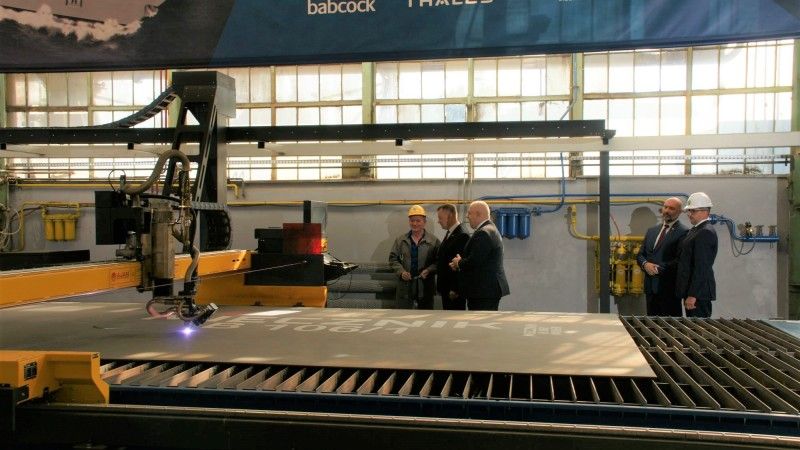First Pieces of Sheet Metal Cut for the ORP Wicher Frigate [REPORT]

Photo. Jarosław Ciślak/Defence24
Last Wednesday PGZ War Shipyard in Gdynia has become a venue where the first sheet metal was cut, in anticipation of the build process for the Project 106 Miecznik frigate. The ship is expected to be named ORP Wicher. The event is a major milestone for this programme.
The text on the first metal sheet and the cutting chart suggests that the prototype would be named ORP Wicher. The unofficial information meanwhile points to the fact, that further series-manufactured vessels of the class would bear the historically significant names ORP Burza, and ORP Huragan.
On 27th July 2021, the head of the Polish MoD, Mariusz Błaszczak, visiting the Polish Navy's base in Gdynia, approved the concluded contract regarding the procurement of three Miecznik frigates, capable of engaging naval, air, and land targets. He announced that it is expected for the prototype to be launched in 4 years - namely in 2025.

Photo. Jarosław Ciślak / Defence24.pl

Photo. Jarosław Ciślak / Defence24.pl

Photo. Jarosław Ciślak / Defence24.pl
Only after the agreement was signed, works were launched aimed at selecting the foreign partner for the project, and the relevant ship design. The UK Babcock company was chosen, with its Arrowhead 140 design bid. After that selection was made, the second phase of creating a Polish frigate, based on a British platform, began. The approval of a contractual design by the Ordering Party made it possible to sign Annex No. 3 to the aforesaid agreement, on 30th June 2023. That Annex precisely defines the tasks assigned to the PGZ-Miecznik consortium. These include building a fully equipped and armed 106/1 prototype, along with two 106/2 and 106/3 platforms (without armament and key electronic/radar systems), and the acquisition of industrial potential by PGZ SW, for building and maintaining the warships in the future.
The first agreement had an associated value of PLN 8 bn. for 3 frigates. Following the annex 3, the amount is higher and is associated with 1 frigate and 2 platforms. Further annexes to the agreement will lead to further changes in price if the Ordering Party decides to procure a full set of weapons and equipment for two series-manufactured vessels.
On 14th August Babcock announced that it has concluded a licensing agreement with PGZ-Miecznik, regarding the Arrowhead 140 design. Thanks to the aforesaid agreement, PGZ-SW will be able to build 3 Miecznik frigates following the Arrowhead design, with individual modifications made to meet the needs of the Polish Navy. The agreement also includes a right of option, making it possible to build another 5 vessels for the Polish Navy, should a need emerge. The licensing agreement guarantees the British company to have the right to seek further customers who could potentially be interested in procuring similar vessels. The PGZ-Miecznik consortium meanwhile has no rights to build vessels based on the Polish variant, without the licensor's approval. The price associated with a single license is unknown.

Photo. Jarosław Ciślak / Defence24.pl

Photo. Jarosław Ciślak / Defence24.pl

Photo. Jarosław Ciślak / Defence24.pl
The Polish Party is creating a technical design, CG 3D model, and working design autonomously - the latter would be the base for the build. The Polish documentation is based on the British original, while the model takes into account the solutions adopted for the British 3D model. Modelling and the development of working documentation began from the bottom section - forming the keel. The keel-laying ceremony is expected to take place during the first quarter of 2024. From the technical standpoint, this could potentially happen in 2023, but the next stage of the build (keel) also entails further payment requested from the Ordering Party.
Read more
All of the events above led to the start of work on the prototype hull, on 16th August 2023, in the presence of the head of the Polish MoD Mariusz Błaszczak, a day after the Polish Armed Forces Day. This is a major success, given the seemingly certain funding secured for this project. The programme has reached the stage at which suspension or cancellation seems to be virtually impossible.
One should be happy about this very important event. The Polish Navy is waiting to receive the frigates that it needs. The first metal sheet cutting is a good signal on the path towards procurement.
One needs to remember about the time flying by. The launch originally planned for 2025 will happen during the 3rd quarter of 2026, considering the current schedule. The prototype is expected to be handed off after the qualification tests - in 2028-2030, which would happen 7-9 years after the agreement was signed. Thus, it is advisable to follow closely the progress of works launched at PGZ S.A. and PGZ SW.

Photo. Jarosław Ciślak / Defence24.pl

Photo. Jarosław Ciślak / Defence24.pl

Photo. Jarosław Ciślak / Defence24.pl



